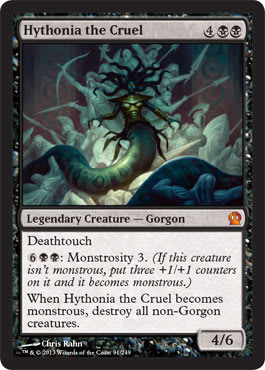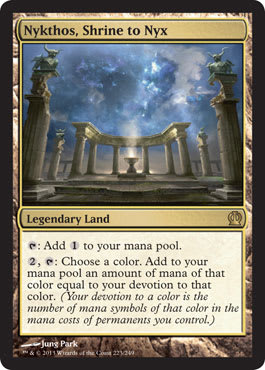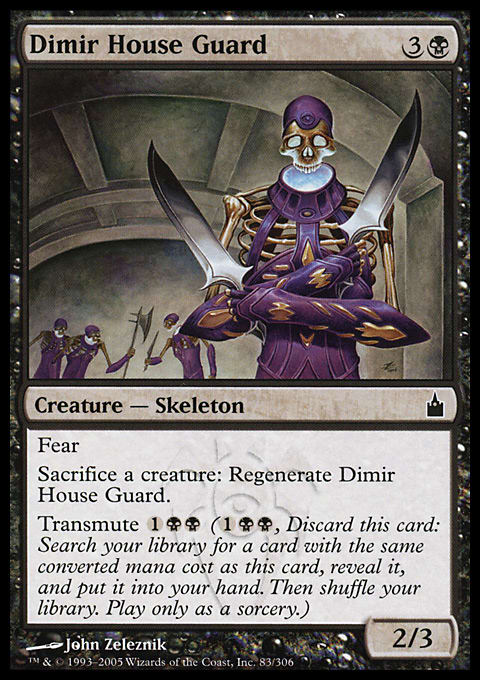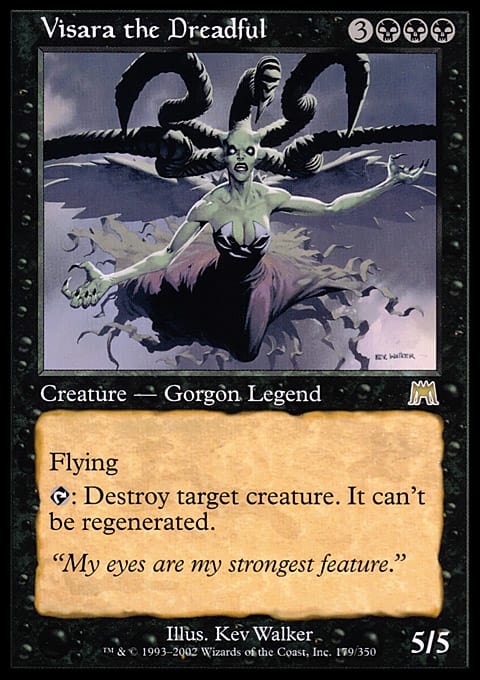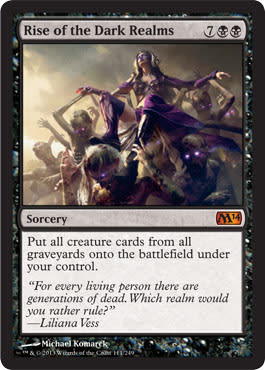Mono-black is my favorite way to play Magic. My first Commander deck was built around Anowon, the Ruin Sage, and that morphed to a Sheoldred, Whispering One deck upon her release. That was a holdover from my (short) period playing Standard with Zendikar-era mono-black Vampires. It helps that, since the days of Necropotence, Mono-Black Control (MBC) has been the dream of many players who are just like I am, who love to grind out games, trade life for cards, and turn every graveyard into extensions of their hands. It almost seems cruel, doesn’t it?
Hythonia doesn’t mess around. Given enough mana and time (and a reasonable sacrifice effect), she’ll keep the world clear of almost every other creature on the battlefield. She also attacks with 7 power—after monstrosity—which means an opponent dies in three hits. That sounds like a good back-up plan, though first, we’re going to need a lot of mana.
In addition to our thirty-one Swamps and a few utility lands, Terrain Generator and the $6.99 Nykthos, Shrine to Nyx do their parts to add to the mana count. Terrain Generator is excellent when you start drawing extra cards, and Nykthos, in a permanent-heavy deck like this one (especially in black, which has more colored mana symbols than any other color has), can generate absurd amounts of mana. We also have a suite of mana rocks, like the underrated Pristine Talisman. MBC tends to be fairly suicidal, and that extra life each turn can keep us alive while we take over. Druidic Satchel and Crystal Ball both work overtime here; when you have them both, things become really crazy, but even one will generate value for not a lot of resources. Don’t be afraid to play your cycling lands if you have them early—only cycle them away if you’ve already gained control of the game and need the extra gas. Magus of the Coffers often makes more mana than Nykthos, and we don’t care if he dies—we’ll just bring him back. Crypt Ghast can power some truly explosive plays, leaving your opponents so far behind they’ll never be able to catch up. Liliana of the Dark Realms will fetch us a Swamp every turn until she’s killed or turns our swamps into
We’re going to need to draw all our lands and sweet control cards, so we have some nifty ways to make that happen. Greed is an absolute all-star (feel free to slot Erebos, God of the Dead in its place if you have one), allowing us to turn leftover mana and life (who cares about that?) into cards. Baleful Force is a Phyrexian Arena on a massive body, and Disciple of Bolas turns our recyclable creatures into piles of cards and life. Syphon Mind can be really disruptive, and it will almost always draw you cards equal to your number of opponents.
Now’s a good time to talk about the elephant in the room. Tutors are not for everyone, and they’re not for every Commander deck. Face-down tutors, especially, are dangerous, and they’re often considered antithetical to the fun, everyone-should-get-to-play ideals that are a major part of the Commander community. I agree—to a point. I think most decks should be built with limited tutoring, and face-up tutors are almost always fairer than face-down tutors. However, you sometimes play with a group that games hard. They combo out and kill the table, or they counter every spell. Tutors are going to be necessary in that kind of situation, and I don’t think there’s anything wrong with having a deck that’s grindy and brutal, as this deck is designed to be. I ask, however, that you remember a couple of things. First, you can always tutor for something other than a combo piece. Tutors can bail you out of a situation, fix your mana, or just grab something really fun. Make sure to read your table and your playgroup and make the choice that’s right for them and the game you’re in. Second, unless you and your playgroup only play hyper-competitive Commander, make sure this isn’t your only deck—or modify it to take out some tutors so at least it’s less consistent. Having a deck like this one along with a super-fun, much fairer deck with no searching (other searching for than lands) is a good place to start. End of aside.
In addition to our draw engines, we have several ways to search up cards and keep the answers flowing. Traditional tutors like Diabolic Tutor, Diabolic Revelation, and Increasing Ambition are great, but the really effective ones are Fleshwrither and especially Dimir House Guard. Both cards can be returned from the graveyard for multiple goes, so we have a bunch of targets at a CMC of 4. The House Guard can fetch for you draw (Greed), a Wrath (Nevinyrral's Disk), graveyard hate (Agent of Erebos), a sac effect (Trading Post), spot removal (Faceless Butcher), recursion (Gravedigger), and so much more. Fleshwrither serves as House Guard number two, finding you the House Guard for you to return to your hand and transmute.
A lot of our threats pull double-duty as answers, which is one of the best things about MBC. Avatar of Woe and Visara the Dreadful are both huge beaters and excellent spot-removal spells. Reiver Demon is a huge beast with a Plague Wind attached. Sepulchral Primordial is not only giant, but it takes away the juiciest targets in our opponent’s ’yards, meaning they can’t recur them (or whatever else they planned to do), and it gives them to us with which to do our dirty work. Nighthowler can be big on its own, what with all the wrathing we can do, and it’s even better bestowed on Hythonia. Soul of Innistrad beats face well all by itself; never mind that it helps us recover our fallen dudes. And Grave Betrayal, especially in combination with Hythonia or another Wrath effect, can set us up with a massive battlefield. However, there is a Plan A (and a Plan A.1, I suppose). Here’s how it works.
Have Nim Deathmantle and Ashnod's Altar on the battlefield. Play Geralf's Messenger. Someone loses 2 life. Now sacrifice the Messenger to Ashnod's Altar. You have ![]() , and Geralf's Messenger undies, returning to the battlefield, causing another 2 life-loss to someone. Sacrifice the Messenger to the Altar again, and you have
, and Geralf's Messenger undies, returning to the battlefield, causing another 2 life-loss to someone. Sacrifice the Messenger to the Altar again, and you have ![]() , meaning you can use Nim Deathmantle to return Geralf's Messenger to the battlefield. Do this as many times as you need to until your opponents are all dead. Plan A.1 requires more mana but probably fewer activations—as long as you can make up the additional
, meaning you can use Nim Deathmantle to return Geralf's Messenger to the battlefield. Do this as many times as you need to until your opponents are all dead. Plan A.1 requires more mana but probably fewer activations—as long as you can make up the additional ![]() for each iteration, you can sacrifice Gray Merchant of Asphodel several times. Barring Oloro, Ageless Ascetic or some other random life-gain deck, normally three or four iterations (for only 8 mana!) is enough to wipe the table out. (If your playgroup doesn’t like infinite combos, I’d pull Geralf's Messenger and replace it with something else, but you want the Altar and the Deathmantle to make the deck run.)
for each iteration, you can sacrifice Gray Merchant of Asphodel several times. Barring Oloro, Ageless Ascetic or some other random life-gain deck, normally three or four iterations (for only 8 mana!) is enough to wipe the table out. (If your playgroup doesn’t like infinite combos, I’d pull Geralf's Messenger and replace it with something else, but you want the Altar and the Deathmantle to make the deck run.)
Fleshbag Marauder works the same way as the Merchant does, but it will make everyone sacrifice their creatures for as long as you can pay
Dictate of Erebos and Butcher of Malakir turn every random sacrifice into an Innocent Blood, and Barter in Blood provides a similar effect on a sorcery. Murder and Tragic Slip serve as additional spot removal, Life's Finale is a great way to wrath the board and remove pesky Eldrazi or similar absurdity from the game, Black Sun's Zenith will even get rid of indestructible dudes and go back to your library, and In Garruk's Wake (in addition to having awesome art in both the normal and promo versions) is a mashup of Plague Wind and multiple copies of Hero's Downfall that will make any Superfriends players very sad. Vampire Hexmage also answers ’Walkers and can be recurred, and Aether Snap will both kill all Planeswalkers on the board and crush the dreams of a tokens player (as well as abruptly terminate any Hydras rampaging around). Spine of Ish Sah is always great and can be sacrificed to Trading Post or Claws of Gix for another go, and Nevinyrral's Disk will get rid of most things all by itself. Agent of Erebos will take care of the graveyard of anyone else intending to abuse it, and Nezumi Graverobber is both graveyard hate and recursion—in one disgusting little Rat Wizard package.
We have a few more recursion spells with Beacon of Unrest and Disturbed Burial, which, like Soul of Innistrad, makes the rest of your creatures much more effective. Archetype of Finality and Visara are both Gorgons, so they don’t die to Hythonia’s monstrosity trigger.
Hythonia the Cruel ? Commander | Mark Wischkaemper
- Commander (0)
- Creatures (24)
- 1 Agent of Erebos
- 1 Archetype of Finality
- 1 Avatar of Woe
- 1 Baleful Force
- 1 Butcher of Malakir
- 1 Crypt Ghast
- 1 Dimir House Guard
- 1 Disciple of Bolas
- 1 Faceless Butcher
- 1 Fleshbag Marauder
- 1 Fleshwrither
- 1 Geralf's Messenger
- 1 Gravedigger
- 1 Gray Merchant of Asphodel
- 1 Magus of the Coffers
- 1 Nezumi Graverobber
- 1 Nighthowler
- 1 Reiver Demon
- 1 Sepulchral Primordial
- 1 Shriekmaw
- 1 Soul of Innistrad
- 1 Vampire Hexmage
- 1 Chainer, Dementia Master
- 1 Visara the Dreadful
- Planeswalkers (1)
- 1 Liliana of the Dark Realms
- Spells (36)
- 1 Murder
- 1 Tragic Slip
- 1 Aether Snap
- 1 Barter in Blood
- 1 Beacon of Unrest
- 1 Black Sun's Zenith
- 1 Diabolic Revelation
- 1 Diabolic Tutor
- 1 Disturbed Burial
- 1 Grim Discovery
- 1 In Garruk's Wake
- 1 Increasing Ambition
- 1 Life's Finale
- 1 Syphon Mind
- 1 Dictate of Erebos
- 1 Grave Betrayal
- 1 Greed
- 1 Ashnod's Altar
- 1 Charcoal Diamond
- 1 Claws of Gix
- 1 Crystal Ball
- 1 Druidic Satchel
- 1 Everflowing Chalice
- 1 Guardian Idol
- 1 Illuminated Folio
- 1 Mind Stone
- 1 Nevinyrral's Disk
- 1 Nim Deathmantle
- 1 Phyrexian Totem
- 1 Pristine Talisman
- 1 Seer's Sundial
- 1 Spine of Ish Sah
- 1 Star Compass
- 1 Trading Post
- 1 Trailblazer's Boots
- 1 Diviner's Wand
- Lands (38)
- 31 Swamp
- 1 Barren Moor
- 1 Bojuka Bog
- 1 Encroaching Wastes
- 1 Polluted Mire
- 1 Reliquary Tower
- 1 Terrain Generator
- 1 Nykthos, Shrine to Nyx
There are a few notable cards missing here. I feel that Rise of the Dark Realms provides too much redundancy with Grave Betrayal, and the curve is already high. I debated running Lashwrithe over Nighthowler for a while, and I decided Nighthowler’s creature status makes it more abusable. Exsanguinate would be awesome if we could afford things like Cabal Coffers with Urborg, Tomb of Yawgmoth or Xiahou Dun, the One-Eyed, but Gray Merchant is much better in this build. And Decree of Pain was among the last cards cut, but at 8 mana and with only one Reliquary Tower—plus a commander who does the same thing for us whenever we need it—it didn’t seem worth it.
Some excellent cards also were skipped due to budget. Sensei's Divining Top, Demonic Tutor, and Vampiric Tutor all would be excellent early-game smoothers and tutors. Cabal Coffers and Urborg, Tomb of Yawgmoth make so much mana it’s ridiculous. Entomb and Reanimate can lead to some truly broken first turns. Grave Pact is an auto-include if you can find one, and I like Wurmcoil Engine in decks that wrath a lot. Hero's Downfall and Slaughter Pact are great straight upgrades to Murder and Tragic Slip—or just solid additions.
The goal here is simple: Survive until you assemble one of your combos or clear the board, and beat down with Hythonia. But beware: Your friends will probably be mad at you.
Total cost: $72.63













